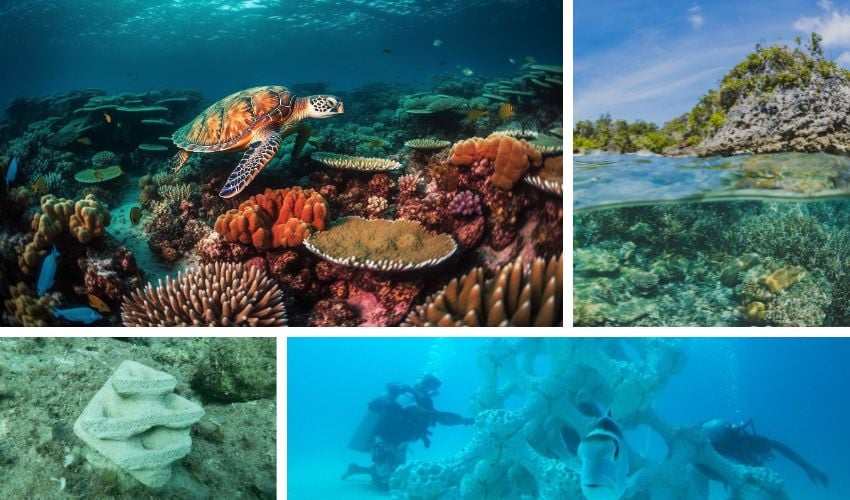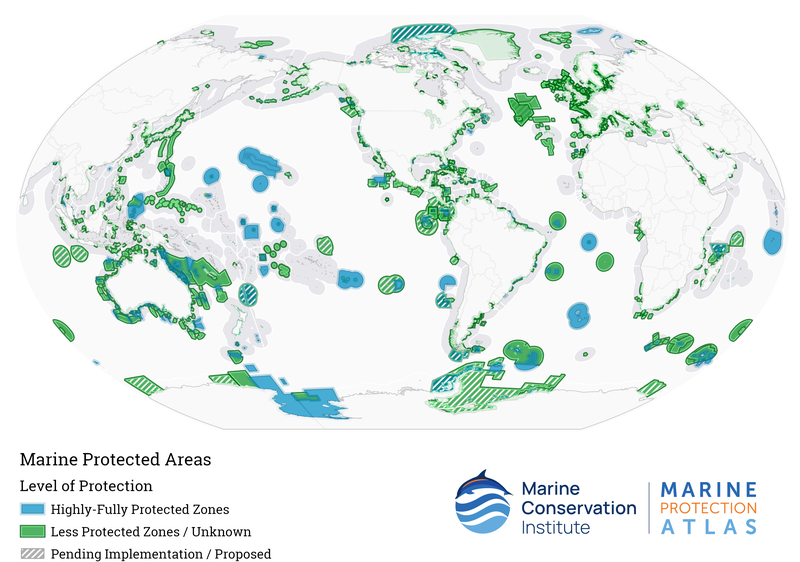Table of Contents
- A Call to Action: The State of Atlantic Marine Habitats
- Coral Reefs: Guardians of Biodiversity
- Coastal Wetlands: Vital Buffer Zones
- Seagrass Meadows: Carbon Capturers
- Marine Protected Areas: Safe Havens for Wildlife
- Collaborative Conservation: International Cooperation
- Empowering Change: Awareness and Education
The Atlantic Ocean, with its vast and diverse ecosystems, is a precious resource that sustains life on our planet. However, this vital marine environment faces numerous challenges, including climate change, overfishing, pollution and habitat destruction. In response to these threats, conservation efforts are underway to protect and preserve the fragile marine habitats of the Atlantic. In this article, we will explore the crucial work being done to safeguard the ocean’s health and biodiversity.
The Atlantic Ocean, a magnificent expanse that stretches across the globe, is an irreplaceable treasure trove of biodiversity. Its diverse ecosystems, from the rich coral reefs of the Caribbean to the icy waters of the North Atlantic, sustain life on Earth in myriad ways. Yet, this invaluable marine environment finds itself at a crossroads, confronted by an array of formidable challenges that threaten its health and resilience. From the unrelenting march of climate change to the relentless pressures of overfishing, pollution and habitat degradation, the Atlantic Ocean’s ecosystems are under siege.
In response to these pressing threats, a global network of scientists, conservationists and concerned citizens has rallied to protect and preserve the fragile balance of life that the Atlantic sustains. Their collective efforts are a testament to the human capacity for stewardship and responsibility. In this article, we embark on a journey through the depths of the Atlantic, exploring the critical work being undertaken to secure the ocean’s well-being and safeguard its precious biodiversity.
Climate Resilience: The Atlantic Ocean is no stranger to the impacts of climate change. Rising sea temperatures and increased acidity disrupt marine ecosystems, affecting species from the microscopic to the iconic. Conservationists are working tirelessly to monitor and understand these changes, seeking to develop strategies that help marine life adapt and thrive in the face of a changing climate. Efforts to establish marine protected areas and reduce greenhouse gas emissions aim to mitigate these impacts and preserve the ocean’s ecological integrity.
Combatting Overfishing: Overfishing poses a grave threat to Atlantic fisheries and the ecosystems they rely on. Conservation measures, including catch limits, seasonal closures and sustainable fishing practices, are being implemented to ensure the long-term health of fish populations. Collaborative agreements among nations seek to prevent overfishing, protecting both the livelihoods of coastal communities and the health of the ocean.
Mitigating Pollution: Pollution, whether from plastics, oil spills or nutrient runoff, tarnishes the Atlantic’s pristine waters. Cleanup efforts, legislation to reduce single-use plastics and innovative technologies to remove pollutants are part of the ongoing battle to keep the Atlantic’s ecosystems free from harm.
Habitat Restoration: Habitat destruction, such as the degradation of coral reefs or the destruction of critical breeding grounds, threatens the Atlantic’s biodiversity. Conservationists are engaged in habitat restoration projects, replanting corals and restoring damaged ecosystems to their former glory. These endeavors aim to create safe havens for marine life to recover and flourish.
Marine Education and Advocacy: Public awareness and advocacy are vital components of Atlantic conservation. Educational programs, documentaries and grassroots campaigns are raising awareness about the importance of the ocean and inspiring collective action to protect it. From beach cleanups to sustainable seafood choices, individuals are becoming guardians of the Atlantic’s future.
In conclusion, the Atlantic Ocean, with its immense biodiversity and ecological significance, demands our vigilant protection. The challenges it faces are global in scale and the solutions require international collaboration and sustained commitment. As we navigate the uncharted waters of the 21st century, our collective responsibility is clear: to ensure that the Atlantic remains a thriving and resilient ocean, a source of wonder and sustenance for generations to come. Through concerted conservation efforts, we strive to safeguard this natural heritage, recognizing that the health of the Atlantic is inextricably linked to the well-being of our planet as a whole.
To delve further into this matter, we encourage you to check out the additional resources provided here: Marine environment
A Call to Action: The State of Atlantic Marine Habitats
The health of the Atlantic’s marine habitats is integral to the well-being of countless species and the global ecosystem. Coral reefs, seagrass beds, kelp forests and coastal wetlands provide essential services, from serving as nurseries for fish to carbon sequestration. Unfortunately, these habitats are under increasing pressure from human activities and environmental changes.
The health of the Atlantic’s marine habitats is integral to the well-being of countless species and the global ecosystem. Coral reefs, seagrass beds, kelp forests and coastal wetlands provide essential services, from serving as nurseries for fish to carbon sequestration. Unfortunately, these habitats are under increasing pressure from human activities and environmental changes and addressing these challenges is imperative for the preservation of marine biodiversity and the stability of our planet.
Coral Reefs: Coral reefs are often referred to as the “rainforests of the sea” due to their incredible biodiversity. They provide shelter and sustenance for an array of marine life, including fish, crustaceans and mollusks. Additionally, they protect coastlines from erosion and storm surges. However, factors such as rising sea temperatures, ocean acidification, pollution and overfishing are causing coral bleaching and the degradation of these fragile ecosystems. Conservation efforts, including marine protected areas and sustainable fishing practices, are essential to safeguarding coral reefs.
Seagrass Beds: Seagrass meadows are crucial breeding and feeding grounds for numerous species of fish and marine invertebrates. They also help improve water quality by trapping sediments and nutrients. Unfortunately, pollution from coastal development and agriculture can lead to seagrass decline. Efforts to reduce nutrient runoff and protect these habitats are vital for maintaining healthy coastal ecosystems.
Kelp Forests: Kelp forests provide habitat for a diverse range of marine organisms, from small fish to sea otters. They also absorb significant amounts of carbon dioxide from the atmosphere, contributing to climate change mitigation. However, warming waters and changes in nutrient availability can lead to declines in kelp forests. Sustainable fisheries management and measures to combat climate change are essential to their preservation.
Coastal Wetlands: Coastal wetlands, including marshes and mangroves, serve as crucial buffers against storm surges, protecting coastal communities from flooding. They also filter pollutants from runoff and provide habitat for birds and marine life. However, urban development and land-use changes have resulted in the destruction of many wetlands. Conservation and restoration efforts are needed to safeguard these valuable ecosystems.
Efforts to address the challenges facing these Atlantic marine habitats must be comprehensive and collaborative. International cooperation, scientific research and public awareness are essential components of effective conservation. Moreover, recognizing the interconnectedness of these ecosystems with global processes such as climate regulation underscores the urgency of our actions.
Preserving the health of the Atlantic’s marine habitats is not just about protecting biodiversity; it’s about ensuring the resilience of our planet in the face of environmental changes. By conserving these habitats and mitigating human impacts, we can help maintain the delicate balance of the marine environment while safeguarding the well-being of both marine and human communities that depend on it.
For a comprehensive look at this subject, we invite you to read more on this dedicated page: Marine Protected Resources – NYS Dept. of Environmental …

Coral Reefs: Guardians of Biodiversity
Coral reefs are among the most biodiverse ecosystems on Earth, providing a home to a stunning array of marine life. Rising ocean temperatures, ocean acidification and physical damage from anchors and fishing gear threaten these fragile ecosystems. Conservation initiatives focus on protecting and restoring coral reefs through the establishment of marine protected areas, coral nurseries and sustainable fishing practices.
Coral reefs, often referred to as the rainforests of the sea, are a testament to the incredible diversity of life within our oceans. These underwater wonderlands are teeming with an astonishing variety of marine species, from colorful corals and mesmerizing fish to turtles, sharks and countless invertebrates. However, these vital ecosystems face a growing array of challenges that demand our immediate attention and action.
One of the most pressing threats to coral reefs is the rise in ocean temperatures brought about by climate change. When sea temperatures become too warm, corals expel the symbiotic algae living in their tissues, a process known as coral bleaching. This not only robs the coral of its vibrant colors but also weakens it, making it more susceptible to disease. To combat this, scientists are researching heat-resistant coral species and investigating ways to mitigate the impacts of warming oceans.
Ocean acidification, caused by the absorption of excess carbon dioxide by seawater, is another perilous threat to coral reefs. As the ocean becomes more acidic, it becomes increasingly difficult for corals to build their calcium carbonate skeletons, which form the foundation of reef structures. Efforts to reduce carbon emissions and mitigate ocean acidification are vital to preserving these fragile ecosystems.
Physical damage from anchors, fishing gear and careless human activities also takes a toll on coral reefs. Anchors dropped onto delicate coral formations can crush them, while discarded fishing nets can smother reefs and trap marine life. Conservation initiatives are working to raise awareness about responsible boating and fishing practices, emphasizing the importance of protecting these fragile underwater habitats.
Conservationists are taking action on multiple fronts to safeguard the future of coral reefs. Marine protected areas are established to limit human impact and give these ecosystems a chance to recover. Coral nurseries are nurturing and transplanting resilient coral species, aiding in their survival. Sustainable fishing practices, such as catch limits and the protection of key breeding grounds, are being implemented to reduce the impact of overfishing.
In sum, the future of coral reefs depends on a collective effort to address the multifaceted challenges they face. These underwater sanctuaries not only harbor unparalleled biodiversity but also provide invaluable ecosystem services such as shoreline protection and tourism revenue. By supporting research, advocating for responsible environmental policies and actively participating in conservation efforts, we can ensure that these remarkable ecosystems continue to thrive and inspire awe for generations to come.
If you’d like to dive deeper into this subject, there’s more to discover on this page: Hope Remains for Deep-Sea Ecosystems along the Atlantic Coast …

Coastal Wetlands: Vital Buffer Zones
Coastal wetlands, including mangrove forests and salt marshes, act as natural buffers against coastal erosion and storm surges. They also serve as nurseries for juvenile fish and provide essential habitat for migratory birds. Preservation efforts involve restoring degraded wetlands, managing development along coastlines and implementing conservation programs that emphasize the ecological value of these areas.
Coastal wetlands, those lush ecosystems encompassing mangrove forests and salt marshes, are like nature’s protective shield for coastal regions, offering multifaceted benefits and requiring dedicated preservation efforts.
Nature’s Armor Against Erosion: Coastal wetlands play an indispensable role in safeguarding our shores against the relentless forces of erosion. The intricate root systems of mangroves and marsh grasses act as formidable barriers, trapping sediment and stabilizing the coastline. This natural defense mechanism mitigates the destructive impact of powerful waves and tides during storms, shielding coastal communities and infrastructure from damage.
Guardians Against Storm Surges: Beyond erosion control, these wetlands act as resilient buffers during hurricanes and cyclones. When storm surges threaten, mangrove forests and salt marshes absorb and dissipate the surge’s energy, reducing the risk of catastrophic flooding. This critical function not only protects human populations but also conserves the delicate balance of coastal ecosystems.
Nurturing Grounds for Marine Life: Coastal wetlands function as vibrant nurseries for a multitude of marine species, including commercially important fish and shellfish. Their sheltered waters and abundant food supply offer an ideal environment for juvenile fish to grow and thrive. Protecting these areas directly supports fisheries, ensuring sustainable seafood harvests for generations to come.
Habitat for Avian Travelers: These wetlands are not just thriving marine ecosystems; they also serve as crucial habitat for migratory birds. Countless species of waterfowl and shorebirds rely on coastal wetlands as stopover points during their long migrations. Preserving these habitats ensures the survival of these avian travelers and contributes to the overall health of ecosystems.
Balancing Act in Conservation: Preserving coastal wetlands involves a delicate balance between development and conservation. While human activities along coastlines are essential for economic growth, they must be managed thoughtfully to minimize the impact on these vital ecosystems. Sustainable coastal development practices and zoning regulations can help strike this balance, allowing both nature and society to thrive.
Restoration for Resilience: In many regions, coastal wetlands have suffered from degradation due to human activities like land reclamation and pollution. Restoration efforts are crucial to revitalize these ecosystems. They involve replanting mangrove stands, removing invasive species and cleaning up pollution. Such endeavors not only enhance the wetlands’ protective capabilities but also revive their biodiversity.
Educating and Advocating: Preserving coastal wetlands requires raising awareness about their ecological significance. Conservation programs and initiatives should emphasize the intrinsic value of these areas, inspiring local communities and governments to prioritize their protection. Public support is often a driving force behind successful preservation efforts.
In summary, coastal wetlands are invaluable ecological treasures, offering protection, nourishment and habitat to both humans and the natural world. Recognizing their importance and committing to their preservation is not just an environmental imperative but also a testament to our stewardship of the delicate balance between development and conservation along our coastlines.
To delve further into this matter, we encourage you to check out the additional resources provided here: Guidelines for Applying Protected Area Management Categories

Seagrass Meadows: Carbon Capturers
Seagrass meadows are exceptional carbon sinks, absorbing and storing carbon dioxide from the atmosphere. They also offer shelter to juvenile fish, feeding grounds for manatees and sea turtles and critical habitats for seahorses and other marine species. Protection and restoration of seagrass beds involve measures to reduce pollution, minimize boat damage and ensure responsible fishing practices.
Seagrass meadows, often overlooked but critically important, are the unsung heroes of our coastal ecosystems. Their significance extends far beyond their serene appearance, as they play a multifaceted role in maintaining the health of our oceans and mitigating climate change.
Carbon Storage Champions: Seagrass meadows are invaluable carbon sinks. They excel at absorbing and storing carbon dioxide from the atmosphere, effectively sequestering carbon and reducing the impact of greenhouse gases. Their ability to capture and retain carbon not only benefits the oceans but also contributes to global efforts to combat climate change.
Nurturing Grounds for Marine Life: These underwater meadows are bustling nurseries for a wide array of marine species. Juvenile fish seek refuge in the sheltered waters of seagrass beds, finding safety from predators among the waving blades. These nurturing grounds play a vital role in sustaining fish populations, contributing to both commercial and recreational fishing industries.
Havens for Iconic Species: Seagrass meadows are critical habitats for some of the ocean’s most iconic and endangered species. Manatees and sea turtles rely on these areas for their primary food source. The seagrass beds offer a constant supply of seagrass shoots, sustaining these gentle giants and helping their populations recover.
Seahorses and Biodiversity: These marine habitats are hotspots of biodiversity, housing a myriad of species. Seahorses, with their unique charm, are among the residents of seagrass meadows. These delicate creatures rely on the meadows’ intricate structure for camouflage and protection.
Threats and Conservation: The protection and restoration of seagrass beds are paramount to preserving their ecological and climate benefits. Conservation efforts include reducing pollution from agricultural runoff and urban development, minimizing boat propeller damage through boating regulations and promoting responsible fishing practices that prevent the disruption of seagrass habitats.
Educational and Scientific Value: Beyond their ecological significance, seagrass meadows offer valuable opportunities for research and education. Scientists study these ecosystems to better understand their role in carbon cycling, marine life dynamics and adaptation to changing environmental conditions. Such knowledge informs conservation strategies and aids in raising awareness about their importance.
Global Impact: Seagrass meadows exist on a global scale, spanning coastlines in various regions. Their combined contribution to carbon sequestration and marine biodiversity underscores their global importance. Protecting and restoring these meadows is a collaborative effort that transcends borders and requires international cooperation.
In summary, seagrass meadows are far more than picturesque underwater landscapes. They are essential players in climate change mitigation, vital nurseries for marine life and critical habitats for iconic species. Their protection and restoration are not only an ecological imperative but a global responsibility, as they contribute to the health and resilience of our oceans and the fight against climate change.
Don’t stop here; you can continue your exploration by following this link for more details: Chapter 5: Changing Ocean, Marine Ecosystems, and Dependent …
Marine Protected Areas: Safe Havens for Wildlife
Marine protected areas (MPAs) are designated regions where human activities are regulated to preserve marine biodiversity. The Atlantic hosts a network of MPAs that offer refuge to a wide range of species. These areas provide critical zones for breeding, feeding and shelter, promoting the recovery of marine populations and safeguarding the resilience of the ocean.
Marine protected areas (MPAs) are invaluable tools in our efforts to safeguard the health and diversity of the Atlantic’s marine ecosystems. Spread across the vast expanse of this ocean, these designated regions serve as havens of conservation, where human activities are carefully regulated to minimize impact and preserve the precious biodiversity within.
The Atlantic’s network of MPAs is as diverse as the ecosystems they protect. From the frigid waters of the North Atlantic to the warm tropical expanses of the South Atlantic, these areas represent a patchwork of underwater sanctuaries that cater to the unique needs of their respective inhabitants. Within these boundaries, marine life flourishes in an environment that closely resembles the oceans of the past, before the pressures of industrialization and overfishing took their toll.
One of the primary roles of these MPAs is to provide essential breeding grounds. Many species of fish, crustaceans and marine mammals rely on specific areas within these protected regions to spawn and rear their young. By safeguarding these critical zones, we help ensure the continuity of countless species. It’s not just about preserving individual animals but maintaining the intricate web of life that depends on these nursery areas for survival.
MPAs also function as vital feeding grounds, particularly for migratory species. As various marine creatures traverse the vast Atlantic, these protected areas offer abundant food sources and respite during their arduous journeys. This is especially crucial for species like whales, dolphins and seabirds, which traverse vast distances in search of sustenance. The protection of these areas ensures that these animals have reliable pit stops on their migratory routes.
Beyond breeding and feeding, MPAs are crucial for providing shelter. As climate change intensifies and ocean conditions become more unpredictable, these protected areas offer refuges where marine life can seek safety from changing temperatures, ocean acidification and other environmental stressors. These refuges become critical not just for individual species but also for the overall resilience of the ocean ecosystem.
Moreover, MPAs serve as living laboratories for scientists to study natural processes without the interference of extensive human activities. They provide a baseline against which researchers can compare the health of ecosystems outside of these protected areas, offering insights into the long-term impacts of human actions on the ocean.
In conclusion, the network of Marine Protected Areas in the Atlantic represents a beacon of hope for the preservation of marine biodiversity. These zones not only provide a sanctuary for a wide range of species but also play a pivotal role in maintaining the health and resilience of the entire ocean. As we expand and strengthen these conservation efforts, we move closer to a future where the Atlantic’s marine ecosystems can thrive in their full splendor for generations to come.
Don’t stop here; you can continue your exploration by following this link for more details: Laws & Policies | NOAA Fisheries

Collaborative Conservation: International Cooperation
The health of the Atlantic’s marine habitats depends on international cooperation. Transboundary challenges like overfishing and pollution require coordinated efforts among countries bordering the Atlantic. Initiatives like the OSPAR Convention and the Sargasso Sea Commission demonstrate how nations are coming together to protect shared resources.
The vitality of the Atlantic’s precious marine habitats stands as a testament to the imperative of international collaboration. As our world becomes increasingly interconnected, challenges that transcend national borders, such as overfishing and pollution, necessitate concerted endeavors among the nations that border the Atlantic Ocean. Initiatives like the OSPAR Convention and the Sargasso Sea Commission exemplify the inspiring ways in which countries are uniting their efforts to safeguard these shared resources and pave the way for a sustainable future.
Overfishing, driven by the ever-growing global demand for seafood, poses a significant threat to the health of Atlantic marine ecosystems. Fish stocks do not adhere to geopolitical boundaries, making it crucial for nations to collaborate in setting and enforcing fishing quotas and regulations. The OSPAR Convention, which focuses on the protection of the marine environment in the Northeast Atlantic, is a prime example of international cooperation. OSPAR brings together nations with coastlines along the Atlantic, working collectively to reduce overfishing, prevent habitat destruction and combat pollution, ensuring the long-term health of this vital ecosystem.
Pollution, whether it be from coastal runoff, shipping activities or industrial discharges, is another pressing issue that knows no borders. The contamination of Atlantic waters can have far-reaching consequences, affecting marine life and human populations alike. Collaborative efforts under the OSPAR Convention extend to combating pollution, striving for cleaner oceans and mitigating the impact of hazardous substances on aquatic ecosystems.
Beyond the well-known OSPAR Convention, the establishment of the Sargasso Sea Commission represents a groundbreaking stride in international marine conservation. The Sargasso Sea, a region of the North Atlantic Ocean known for its unique biodiversity and vast floating mats of sargassum seaweed, lies outside the jurisdiction of any single nation. This presented a governance challenge until the formation of the Sargasso Sea Commission, which unites multiple countries in a concerted effort to protect this vital ecosystem. By fostering cooperation and conservation efforts, the commission aims to safeguard the Sargasso Sea’s fragile ecosystem and ensure its long-term resilience in the face of global environmental pressures.
These initiatives, along with many others, exemplify how nations with diverse interests can put aside differences and prioritize the protection of shared resources. In doing so, they not only preserve the health and vitality of the Atlantic Ocean but also set a precedent for global cooperation in addressing the complex environmental challenges that our planet faces. The Atlantic, with its vast and interconnected ecosystems, serves as a reminder that the fate of our world’s oceans depends on our ability to work together for the greater good, transcending borders and uniting for the sake of our shared natural heritage.
If you’d like to dive deeper into this subject, there’s more to discover on this page: Discovery and Conservation | Florida Atlantic University

Empowering Change: Awareness and Education
Education and public awareness are integral components of conservation efforts. Environmental organizations, scientists and local communities are working together to raise awareness about the importance of marine habitat preservation. Engaging the public in conservation initiatives fosters a sense of responsibility and empowers individuals to make sustainable choices.
Education and public awareness stand as the cornerstone of successful conservation efforts, particularly when it comes to preserving the fragile and vital marine habitats of our planet. A collective commitment to understanding the value of our oceans and their ecosystems is essential to catalyze effective change and ensure the long-term health of these environments.
Environmental organizations, often at the forefront of these initiatives, play a pivotal role in educating the public about the significance of marine habitat preservation. Through outreach programs, workshops and multimedia campaigns, these organizations convey the intricate web of life that depends on healthy oceans. They emphasize the ecological services provided by marine ecosystems, such as oxygen production, carbon sequestration and the regulation of climate and weather patterns, underscoring the direct and indirect ways in which these habitats impact our lives.
Equally crucial are the tireless efforts of scientists who study marine ecosystems and provide valuable insights into their complexities. Their research not only expands our knowledge but also serves as a powerful tool for raising public awareness. Through documentaries, publications and public lectures, scientists bridge the gap between specialized research and the broader understanding of marine conservation issues.
Local communities living in coastal regions often possess a deep connection to the sea, relying on it for sustenance, livelihoods and cultural heritage. Collaborative efforts involving these communities are vital in promoting marine habitat preservation. These communities, when empowered with knowledge and resources, become stewards of their local marine environments, working to sustainably manage fisheries, protect vulnerable species and combat pollution.
The impact of these educational and awareness-raising initiatives is profound. They nurture a sense of responsibility among individuals and communities, instilling a shared commitment to protecting the oceans. Armed with knowledge, people are more likely to make sustainable choices in their daily lives, such as reducing single-use plastics, supporting sustainable seafood practices and advocating for policies that safeguard marine habitats.
Furthermore, public engagement creates a groundswell of support for conservation efforts. This support translates into political pressure and the allocation of resources to protect marine ecosystems. Conservation initiatives are more likely to gain momentum when individuals and communities demand action from policymakers and businesses.
In essence, education and public awareness are catalysts for a brighter future for our oceans. They empower individuals and communities to become active participants in marine habitat preservation, forging a path toward a sustainable coexistence with the seas that have nurtured life on our planet for eons. By fostering an understanding of the value and fragility of these ecosystems, we can collectively work towards ensuring that the beauty and richness of our oceans endure for generations to come.
Looking for more insights? You’ll find them right here in our extended coverage: Guidelines for Applying Protected Area Management Categories

Conservation efforts in the Atlantic are a testament to humanity’s commitment to preserving the health and vitality of our planet’s oceans. Protecting fragile marine habitats is not just an environmental imperative but also essential for our own well-being. As we continue to confront the challenges facing the Atlantic, our collective actions to safeguard these vital ecosystems will determine the future health and resilience of this magnificent ocean. Through dedication, collaboration and education, we can ensure that the Atlantic’s marine habitats remain vibrant and teeming with life for generations to come.
Conservation efforts in the Atlantic Ocean are emblematic of our shared responsibility to be stewards of the natural world. Expanding on this idea, let’s explore the multifaceted significance of these endeavors and the positive outcomes they can achieve:
Ecosystem Health and Biodiversity: Conservation initiatives in the Atlantic aim to protect and restore fragile marine ecosystems. These efforts not only safeguard the diverse species that call the Atlantic home but also contribute to the overall health and resilience of the ocean. Healthy ecosystems are better equipped to withstand environmental challenges and provide essential services, such as fisheries and carbon sequestration.
Balancing Human Needs: The Atlantic Ocean sustains the livelihoods of countless coastal communities through fisheries, tourism and maritime trade. Conservation efforts seek to strike a balance between human needs and the preservation of marine habitats. Sustainable fisheries management, responsible tourism practices and marine protected areas are examples of strategies that support both economic well-being and environmental health.
Climate Change Mitigation: Oceans play a critical role in regulating the Earth’s climate. Conservation measures that protect and restore marine habitats, such as mangroves, seagrasses and coral reefs, can help mitigate the impacts of climate change. These habitats store carbon, protect coastlines from erosion and serve as nurseries for marine life, contributing to the overall resilience of the ocean.
Resilience in the Face of Challenges: The Atlantic Ocean faces numerous challenges, including overfishing, habitat degradation, plastic pollution and the impacts of climate change. Conservation efforts are essential for building resilience in the face of these challenges. This resilience not only benefits marine life but also helps coastal communities adapt to changing conditions.
International Collaboration: The Atlantic Ocean is vast and interconnected, spanning multiple countries and regions. Conservation efforts often require international collaboration and the alignment of policies and regulations. Initiatives like marine protected areas and transboundary conservation agreements demonstrate the power of collective action.
Scientific Advancements: Conservation in the Atlantic is informed by cutting-edge research and scientific discoveries. Advances in marine biology, ecology and oceanography provide insights into the complex dynamics of ocean ecosystems. This knowledge guides the development of effective conservation strategies.
Public Awareness and Education: Public awareness and education play a crucial role in conservation. Engaging communities, schools and individuals in understanding the importance of the Atlantic Ocean fosters a sense of responsibility and encourages sustainable behaviors.
Economic Opportunities: Conservation can also generate economic opportunities. Ecotourism, for example, allows people to experience the beauty and wonder of the Atlantic’s marine life while supporting conservation efforts. Sustainable businesses that operate in harmony with the environment contribute to both ecological and economic well-being.
Long-Term Commitment: Conservation is a long-term commitment. It requires ongoing monitoring, adaptive management and a dedication to preserving the integrity of the Atlantic’s marine habitats. The fruits of these efforts may not always be immediate, but they are vital for the long-term health of our oceans.
In conclusion, conservation efforts in the Atlantic Ocean reflect our responsibility to protect and cherish the natural world. These efforts are not only an investment in the health of the ocean but also in our own well-being and the well-being of future generations. Through collaboration, innovation and a deep sense of stewardship, we can ensure that the Atlantic’s marine habitats remain vibrant and resilient, continuing to inspire and sustain life for years to come.
Additionally, you can find further information on this topic by visiting this page: Beluga Whale | NOAA Fisheries
More links
Explore this link for a more extensive examination of the topic: North Atlantic Right Whale | NOAA Fisheries
